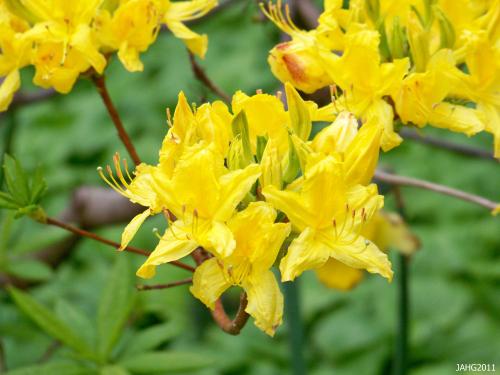This week the America Iris Society is having its national convention here in Victoria. All the important public gardens have been prepared in the last year for the event by planting out beds of many species, hybrids and cultivars in them. With the cooler than normal spring that has effected this area of the continent most of the plants are behind their bloom schedule. One of the important species is looking lovely non the less and has some blooms. I am referring to Iris pallida and in particular the variegated forms of Iris pallida ‘Argentea Variegata’ and I.p. ‘Variegata’ (Variegated Sweet Iris).
Iris pallida comes from the Dalmatian Coast (former Yugoslavia) into northern Greece and up into northern Italy. It is sometimes called the Dalmatian Iris for this reason The plant is fairly variable in flower color ranging from dark purple, lighter purple into pink and white. With the color variablity there are also several subspecies (ssp.). I.p. ssp. pallida has pale lavender flowers originates in western former Yugoslavia where it grows on the limestone cliffs there. I.p. ssp. cengialtii has darker purple flowers with white or orange tipped beard and greener leaves and is found in north-east Italy. Iris pallida ssp. illyrica is sometimes classed as a separate species (Iris illyrica) and the issue at this point is unresolved. It has mid purple flowers and is found in its namesake, ancient Illyrica (northern Dalmatian coast). I.p. ssp. pseudopallida comes from the southern Dalmatian coast. There is another subspecies that is known as I.p. ssp. musulmanica which I can not find any information about.

Iris pallida has unmistakable grape scented blossoms which delights and excites the nose and is reminds many of us of our youth.
I worked for many years in the wholesale area of horticulture and during that time was able to observe many plants over a long time in different conditions. Variegated Sweet Iris was imported into Canada by the perennial grower I worked for and I could compare it to many other Iris species, cultivars and hybrids at the time. Not only was I.p. ‘Argentea Variegata’ brought in but the golden variegated (‘Aureo Variegata’) form was brought in. It was clear at that time that I.p. ‘Argentea Variegata’ was the better form, is stronger growing an is less prone to disease in the wet winters we have here. This may be the reason that I.p. ‘Aureo Variegata’ is not seen and probably not sold in this area any more.
There is another variegated Sweet Iris which is often mixed up with Iris pallida ‘Argentea Variegata’ and it is I.pallida ‘ Variegata’. It is hard to tell them apart at a glance but Iris pallida ‘Variegata’ is much whiter and does not get the creamy- buttery tones in its leaves. It is also said that it is more vigorous but I can not say this is true as I have not seen the plant growing over a period of time to say for sure.I feel it is likely these plants are much mixed up in trade and often mis-labeled for each other.

This I believe is Iris pallida 'Variegata', as you can see there is no real buttery coloring in the foliage. Note all the pictures in this article were taken on the same day in one garden.
We are fortunate that Iris pallida ‘Argentea Variegata’ is much easier to obtain today and is an easy plant to grow in our gardens. It needs a bright location with full sun to part shade to bring out its best qualities. As with all rhizome producing Iris it is important to plant them very shallowly. It likes very good drainage with humus rich soil, this is particularly important if you live in areas of high humidity or have to deal with wet winter like we have here. Good air circulation is a good idea as this will help dispel any fungus which might be lurking about. You will see signs of fungus with leaf spotting and greyish discoloration along the blade edges. Keeping the area clean and removing spent leaves is also important for the same reason. Plant rhizomes should be divided every 3-4 years to thin the plants out and renew soil.
- These Iris pallida ‘Argentea Variegata’ (Sweet Variegated Iris) were planted for the American Iris Society convention which is be held in Victoria this year.
Iris pallida and its forms are reliably hardy to zone 5 or -23 c. (-2o f.) and I have read that they can be pushed to even colder zones if they are well protected. These plants grow 60 cm. (24 in.) high and about 30 cm. (12 in.) wide. Variegated Sweet Iris are specimen plants which do not need competition in the garden so keep other plants at a distance to show them off. They definitely can be used as an accent and make the most impact mass planted. They can also be used in containers and are most often seen in perennial borders.
Finding your Variegated iris:
American Iris Society: http://www.irises.org/
Where does this species come from: http://en.wikipedia.org/wiki/Illyria
Iris pallida is an ancient plant but not much is written about it: http://en.wikipedia.org/wiki/Iris_pallida
……I hope you will be reading what I write again….soon…..


























 Stumble It!
Stumble It!






